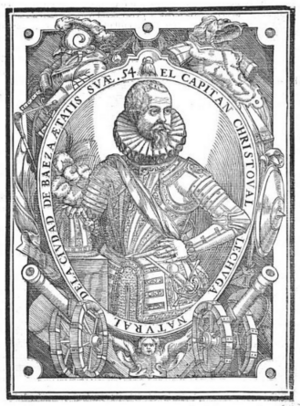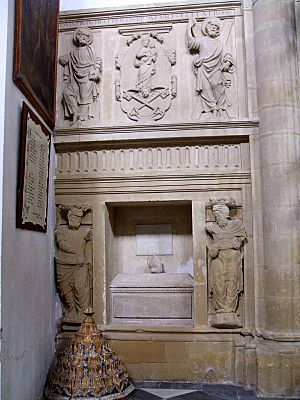Cristobal Lechuga facts for kids
Quick facts for kids
Cristóbal Lechuga
|
|
|---|---|
 |
|
| Born | 1557 |
| Died | 1622 Unknown place
|
| Nationality | Spanish |
| Occupation | Military Engineer |
| Known for | Treatise on Artillery and Fortification |
| Signature | |
Cristóbal Lechuga was a Spanish soldier and mathematician. He lived from about 1557 to 1622. He is famous for writing important books about how to use cannons (artillery) and how to build strong defenses (fortification).
Contents
Life of Cristóbal Lechuga
Early Military Career
We don't know much about Cristóbal Lechuga's early life. He joined the army when he was just 18 years old. In 1585, he was a sergeant in an army fighting in Flanders. Later, in 1590, he was briefly held in prison.
From 1593, Lechuga became an artillery officer. He fought in many wars for Spain. These included battles against Henry IV of France and rebels in Flanders. He took part in several important sieges. These were at La Chapelle (1594), Doullens, Cambray (1595), and Calais (1596). He also helped defend Amiens in 1597. During this time, he met a powerful supporter named Pedro Enríquez of Acevedo. This person later became the governor of Milan in 1600.
Work in Milan and Beyond
Starting in 1600, Lechuga worked as an inspector of fortifications in the Duchy of Milan. He went on many secret missions for Spain. He also helped start the Academy of Artillery in Milan. This academy was approved by King Philip III of Spain. From Milan, Lechuga suggested that Spain should create a similar academy in Madrid.
In 1610, his supporter, the count of Fuentes, passed away. This left Lechuga without strong political backing. However, in 1613, he moved to the Royal Navy in Cadiz. He was made a lieutenant general there.
Governor of La Mamora
In 1614, Lechuga joined an expedition to La Mamora. This place is now called Mehdya in Morocco. After the Spanish conquered it, Lechuga was made governor. His job was to build strong forts there.
In 1620, local Moroccan groups attacked La Mamora. They surrounded the fort. Reinforcements from Cadiz broke the siege in 1621. In September 1622, a new governor was appointed for La Mamora. It is not known if Cristóbal Lechuga died or resigned from his post at that time.
His Final Resting Place
Around 1618 or 1619, Lechuga may have visited his hometown of Baeza. He built a family chapel in the Santa Cruz church. He wanted to be buried there. This chapel was later moved to Baeza's Cathedral in 1835. You can still see it there today.
Important Writings
Cristóbal Lechuga wrote two important books about military techniques.
- Discurso en el que trata del cargo de Maestro de Campo General (Milan, 1603): This book was likely written when he was in Flanders. It was published a few years later. In it, Lechuga argued that military officers should be judged by their skills and training. He believed their professional knowledge was more important than old traditions.
- Discurso en el que trata de la Artilleria con un tratado de Fortificación (Milan, 1611): This book continued his focus on military professionalism. Lechuga believed that artillery (cannons) was the most important part of a modern army. He discussed how to make cannons better. He suggested standardizing their size and how they were placed. His ideas were based on science and engineering.
See also
 In Spanish: Cristóbal Lechuga para niños
In Spanish: Cristóbal Lechuga para niños


